Impact of the US and China Trade War.
VerifiedAdded on 2022/09/07
|13
|3467
|17
AI Summary
Contribute Materials
Your contribution can guide someone’s learning journey. Share your
documents today.
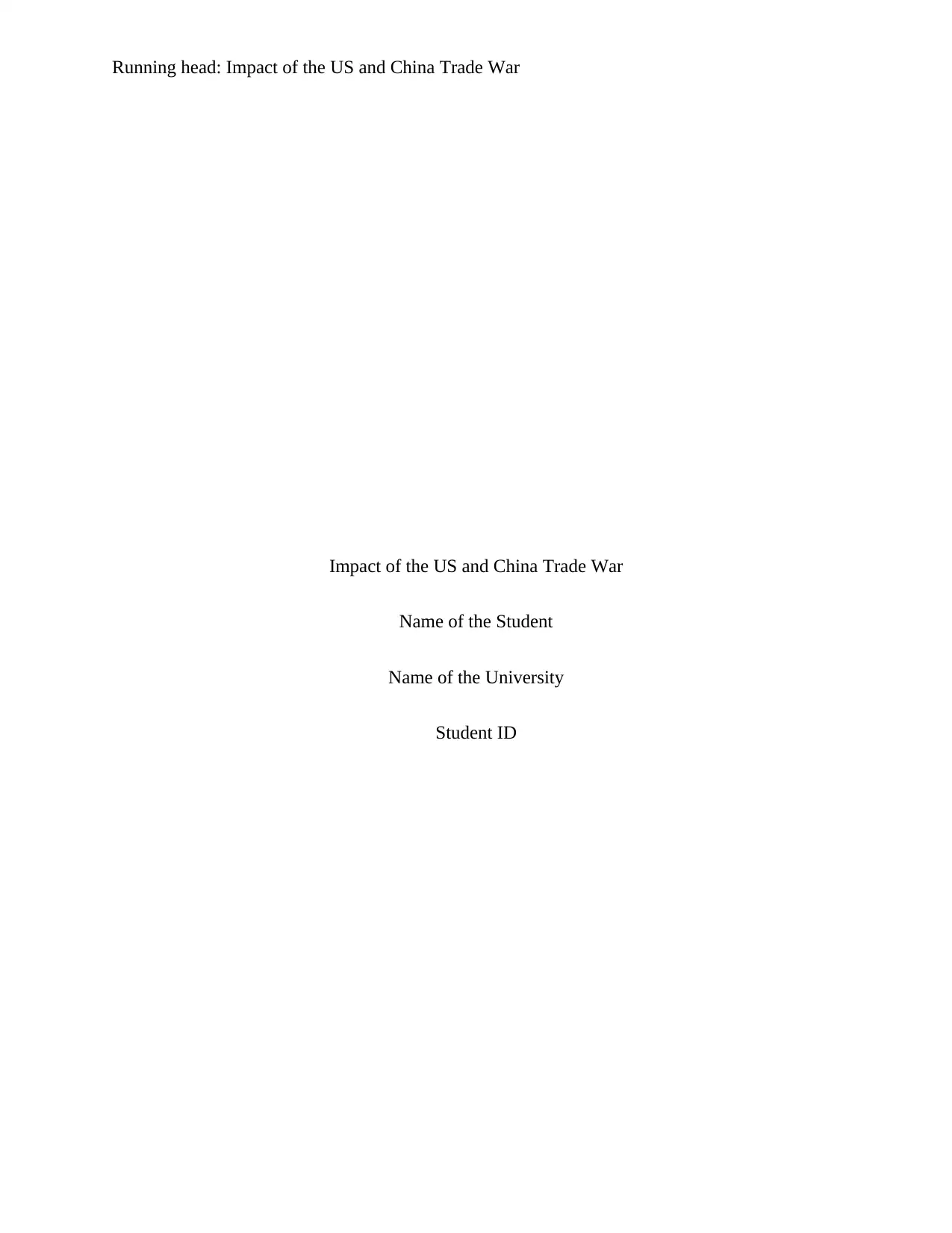
Running head: Impact of the US and China Trade War
Impact of the US and China Trade War
Name of the Student
Name of the University
Student ID
Impact of the US and China Trade War
Name of the Student
Name of the University
Student ID
Secure Best Marks with AI Grader
Need help grading? Try our AI Grader for instant feedback on your assignments.
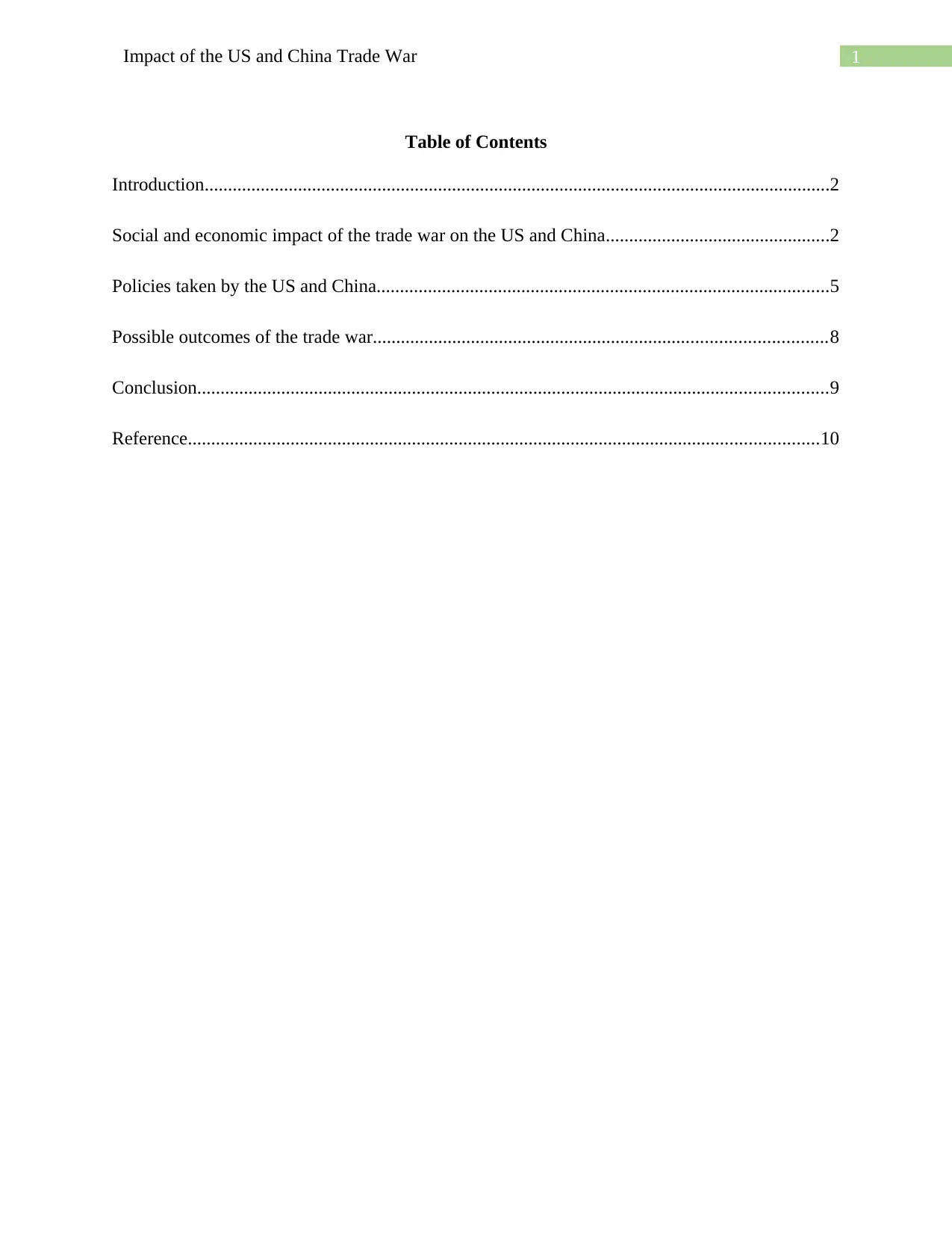
1Impact of the US and China Trade War
Table of Contents
Introduction......................................................................................................................................2
Social and economic impact of the trade war on the US and China................................................2
Policies taken by the US and China.................................................................................................5
Possible outcomes of the trade war.................................................................................................8
Conclusion.......................................................................................................................................9
Reference.......................................................................................................................................10
Table of Contents
Introduction......................................................................................................................................2
Social and economic impact of the trade war on the US and China................................................2
Policies taken by the US and China.................................................................................................5
Possible outcomes of the trade war.................................................................................................8
Conclusion.......................................................................................................................................9
Reference.......................................................................................................................................10
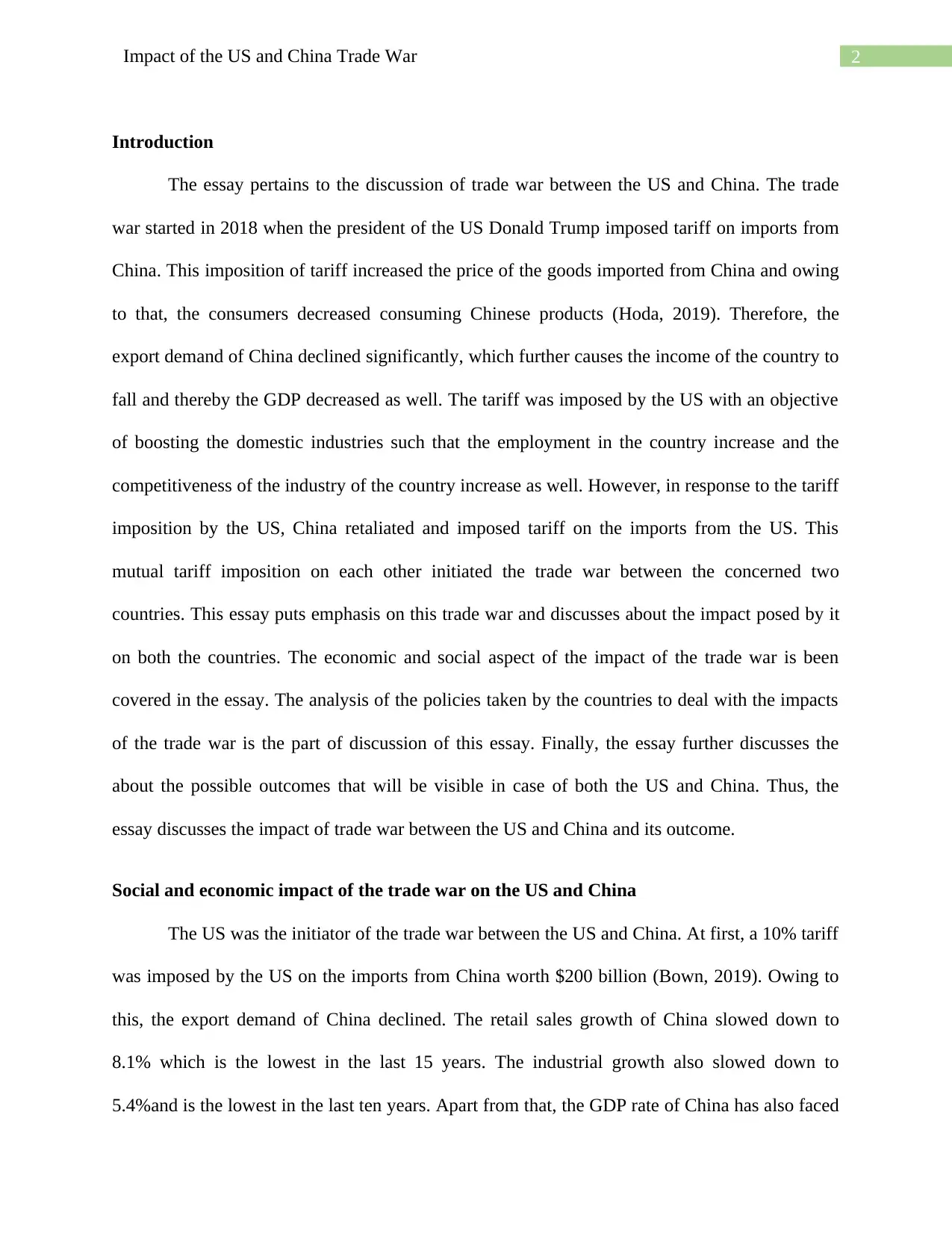
2Impact of the US and China Trade War
Introduction
The essay pertains to the discussion of trade war between the US and China. The trade
war started in 2018 when the president of the US Donald Trump imposed tariff on imports from
China. This imposition of tariff increased the price of the goods imported from China and owing
to that, the consumers decreased consuming Chinese products (Hoda, 2019). Therefore, the
export demand of China declined significantly, which further causes the income of the country to
fall and thereby the GDP decreased as well. The tariff was imposed by the US with an objective
of boosting the domestic industries such that the employment in the country increase and the
competitiveness of the industry of the country increase as well. However, in response to the tariff
imposition by the US, China retaliated and imposed tariff on the imports from the US. This
mutual tariff imposition on each other initiated the trade war between the concerned two
countries. This essay puts emphasis on this trade war and discusses about the impact posed by it
on both the countries. The economic and social aspect of the impact of the trade war is been
covered in the essay. The analysis of the policies taken by the countries to deal with the impacts
of the trade war is the part of discussion of this essay. Finally, the essay further discusses the
about the possible outcomes that will be visible in case of both the US and China. Thus, the
essay discusses the impact of trade war between the US and China and its outcome.
Social and economic impact of the trade war on the US and China
The US was the initiator of the trade war between the US and China. At first, a 10% tariff
was imposed by the US on the imports from China worth $200 billion (Bown, 2019). Owing to
this, the export demand of China declined. The retail sales growth of China slowed down to
8.1% which is the lowest in the last 15 years. The industrial growth also slowed down to
5.4%and is the lowest in the last ten years. Apart from that, the GDP rate of China has also faced
Introduction
The essay pertains to the discussion of trade war between the US and China. The trade
war started in 2018 when the president of the US Donald Trump imposed tariff on imports from
China. This imposition of tariff increased the price of the goods imported from China and owing
to that, the consumers decreased consuming Chinese products (Hoda, 2019). Therefore, the
export demand of China declined significantly, which further causes the income of the country to
fall and thereby the GDP decreased as well. The tariff was imposed by the US with an objective
of boosting the domestic industries such that the employment in the country increase and the
competitiveness of the industry of the country increase as well. However, in response to the tariff
imposition by the US, China retaliated and imposed tariff on the imports from the US. This
mutual tariff imposition on each other initiated the trade war between the concerned two
countries. This essay puts emphasis on this trade war and discusses about the impact posed by it
on both the countries. The economic and social aspect of the impact of the trade war is been
covered in the essay. The analysis of the policies taken by the countries to deal with the impacts
of the trade war is the part of discussion of this essay. Finally, the essay further discusses the
about the possible outcomes that will be visible in case of both the US and China. Thus, the
essay discusses the impact of trade war between the US and China and its outcome.
Social and economic impact of the trade war on the US and China
The US was the initiator of the trade war between the US and China. At first, a 10% tariff
was imposed by the US on the imports from China worth $200 billion (Bown, 2019). Owing to
this, the export demand of China declined. The retail sales growth of China slowed down to
8.1% which is the lowest in the last 15 years. The industrial growth also slowed down to
5.4%and is the lowest in the last ten years. Apart from that, the GDP rate of China has also faced
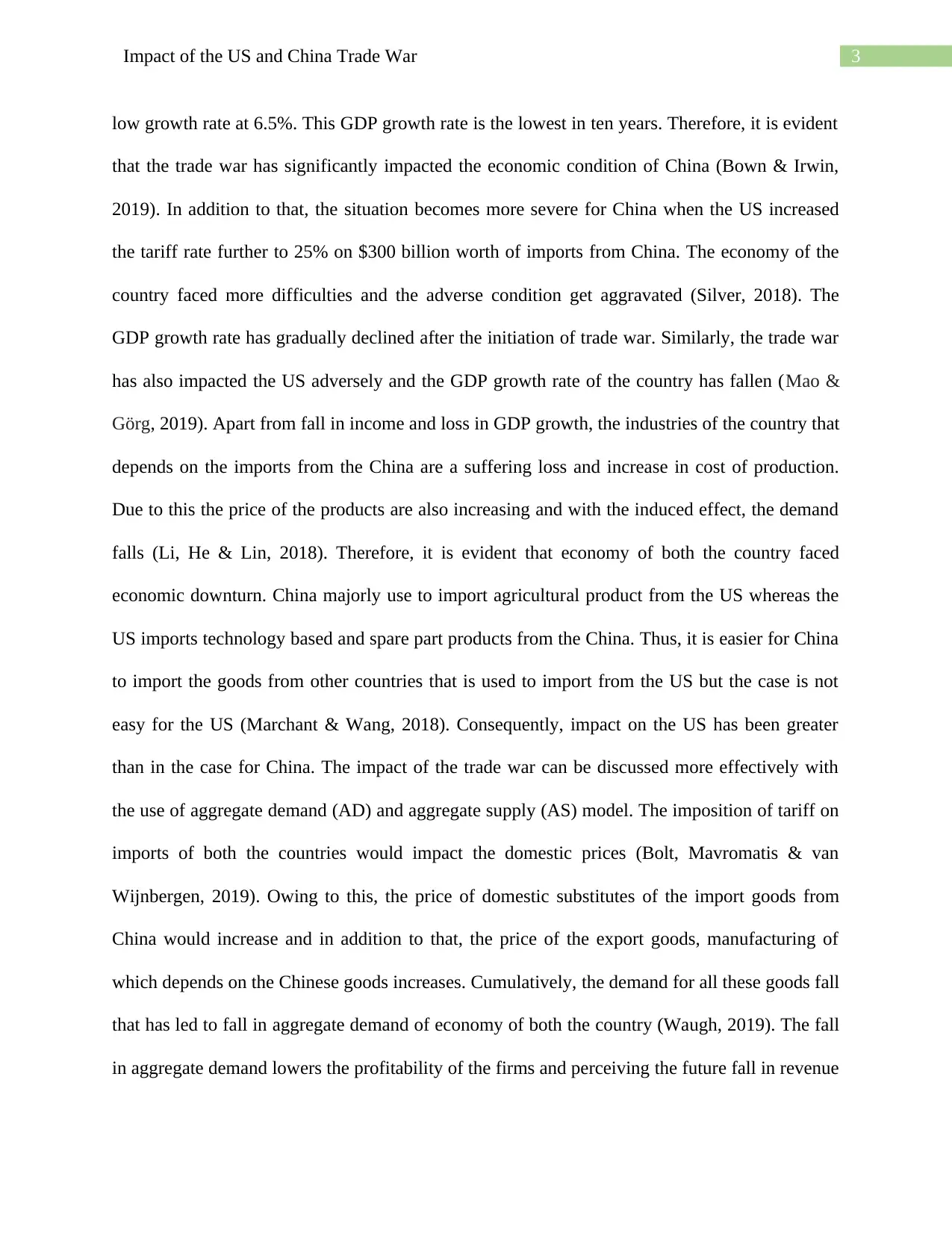
3Impact of the US and China Trade War
low growth rate at 6.5%. This GDP growth rate is the lowest in ten years. Therefore, it is evident
that the trade war has significantly impacted the economic condition of China (Bown & Irwin,
2019). In addition to that, the situation becomes more severe for China when the US increased
the tariff rate further to 25% on $300 billion worth of imports from China. The economy of the
country faced more difficulties and the adverse condition get aggravated (Silver, 2018). The
GDP growth rate has gradually declined after the initiation of trade war. Similarly, the trade war
has also impacted the US adversely and the GDP growth rate of the country has fallen (Mao &
Görg, 2019). Apart from fall in income and loss in GDP growth, the industries of the country that
depends on the imports from the China are a suffering loss and increase in cost of production.
Due to this the price of the products are also increasing and with the induced effect, the demand
falls (Li, He & Lin, 2018). Therefore, it is evident that economy of both the country faced
economic downturn. China majorly use to import agricultural product from the US whereas the
US imports technology based and spare part products from the China. Thus, it is easier for China
to import the goods from other countries that is used to import from the US but the case is not
easy for the US (Marchant & Wang, 2018). Consequently, impact on the US has been greater
than in the case for China. The impact of the trade war can be discussed more effectively with
the use of aggregate demand (AD) and aggregate supply (AS) model. The imposition of tariff on
imports of both the countries would impact the domestic prices (Bolt, Mavromatis & van
Wijnbergen, 2019). Owing to this, the price of domestic substitutes of the import goods from
China would increase and in addition to that, the price of the export goods, manufacturing of
which depends on the Chinese goods increases. Cumulatively, the demand for all these goods fall
that has led to fall in aggregate demand of economy of both the country (Waugh, 2019). The fall
in aggregate demand lowers the profitability of the firms and perceiving the future fall in revenue
low growth rate at 6.5%. This GDP growth rate is the lowest in ten years. Therefore, it is evident
that the trade war has significantly impacted the economic condition of China (Bown & Irwin,
2019). In addition to that, the situation becomes more severe for China when the US increased
the tariff rate further to 25% on $300 billion worth of imports from China. The economy of the
country faced more difficulties and the adverse condition get aggravated (Silver, 2018). The
GDP growth rate has gradually declined after the initiation of trade war. Similarly, the trade war
has also impacted the US adversely and the GDP growth rate of the country has fallen (Mao &
Görg, 2019). Apart from fall in income and loss in GDP growth, the industries of the country that
depends on the imports from the China are a suffering loss and increase in cost of production.
Due to this the price of the products are also increasing and with the induced effect, the demand
falls (Li, He & Lin, 2018). Therefore, it is evident that economy of both the country faced
economic downturn. China majorly use to import agricultural product from the US whereas the
US imports technology based and spare part products from the China. Thus, it is easier for China
to import the goods from other countries that is used to import from the US but the case is not
easy for the US (Marchant & Wang, 2018). Consequently, impact on the US has been greater
than in the case for China. The impact of the trade war can be discussed more effectively with
the use of aggregate demand (AD) and aggregate supply (AS) model. The imposition of tariff on
imports of both the countries would impact the domestic prices (Bolt, Mavromatis & van
Wijnbergen, 2019). Owing to this, the price of domestic substitutes of the import goods from
China would increase and in addition to that, the price of the export goods, manufacturing of
which depends on the Chinese goods increases. Cumulatively, the demand for all these goods fall
that has led to fall in aggregate demand of economy of both the country (Waugh, 2019). The fall
in aggregate demand lowers the profitability of the firms and perceiving the future fall in revenue
Secure Best Marks with AI Grader
Need help grading? Try our AI Grader for instant feedback on your assignments.
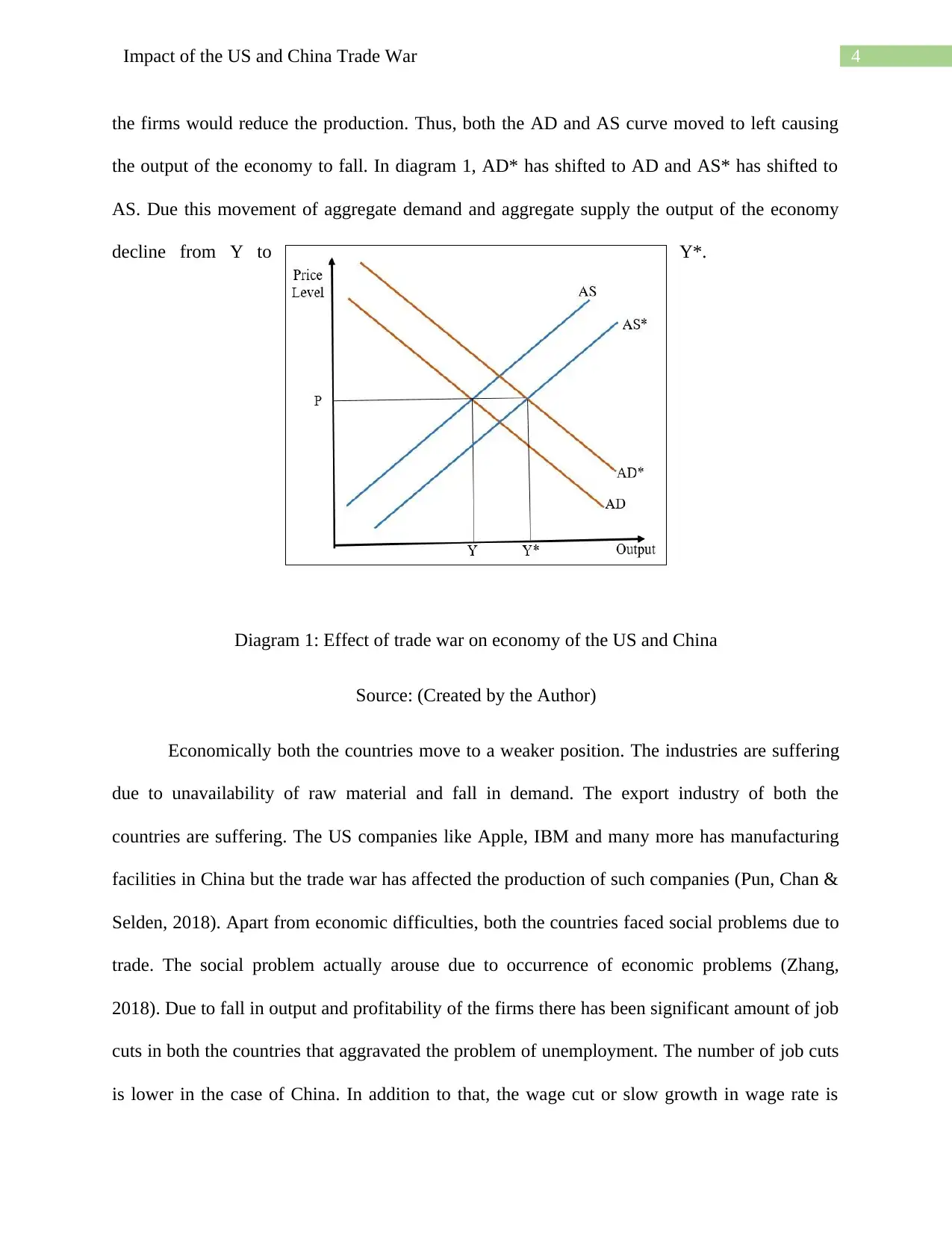
4Impact of the US and China Trade War
the firms would reduce the production. Thus, both the AD and AS curve moved to left causing
the output of the economy to fall. In diagram 1, AD* has shifted to AD and AS* has shifted to
AS. Due this movement of aggregate demand and aggregate supply the output of the economy
decline from Y to Y*.
Diagram 1: Effect of trade war on economy of the US and China
Source: (Created by the Author)
Economically both the countries move to a weaker position. The industries are suffering
due to unavailability of raw material and fall in demand. The export industry of both the
countries are suffering. The US companies like Apple, IBM and many more has manufacturing
facilities in China but the trade war has affected the production of such companies (Pun, Chan &
Selden, 2018). Apart from economic difficulties, both the countries faced social problems due to
trade. The social problem actually arouse due to occurrence of economic problems (Zhang,
2018). Due to fall in output and profitability of the firms there has been significant amount of job
cuts in both the countries that aggravated the problem of unemployment. The number of job cuts
is lower in the case of China. In addition to that, the wage cut or slow growth in wage rate is
the firms would reduce the production. Thus, both the AD and AS curve moved to left causing
the output of the economy to fall. In diagram 1, AD* has shifted to AD and AS* has shifted to
AS. Due this movement of aggregate demand and aggregate supply the output of the economy
decline from Y to Y*.
Diagram 1: Effect of trade war on economy of the US and China
Source: (Created by the Author)
Economically both the countries move to a weaker position. The industries are suffering
due to unavailability of raw material and fall in demand. The export industry of both the
countries are suffering. The US companies like Apple, IBM and many more has manufacturing
facilities in China but the trade war has affected the production of such companies (Pun, Chan &
Selden, 2018). Apart from economic difficulties, both the countries faced social problems due to
trade. The social problem actually arouse due to occurrence of economic problems (Zhang,
2018). Due to fall in output and profitability of the firms there has been significant amount of job
cuts in both the countries that aggravated the problem of unemployment. The number of job cuts
is lower in the case of China. In addition to that, the wage cut or slow growth in wage rate is
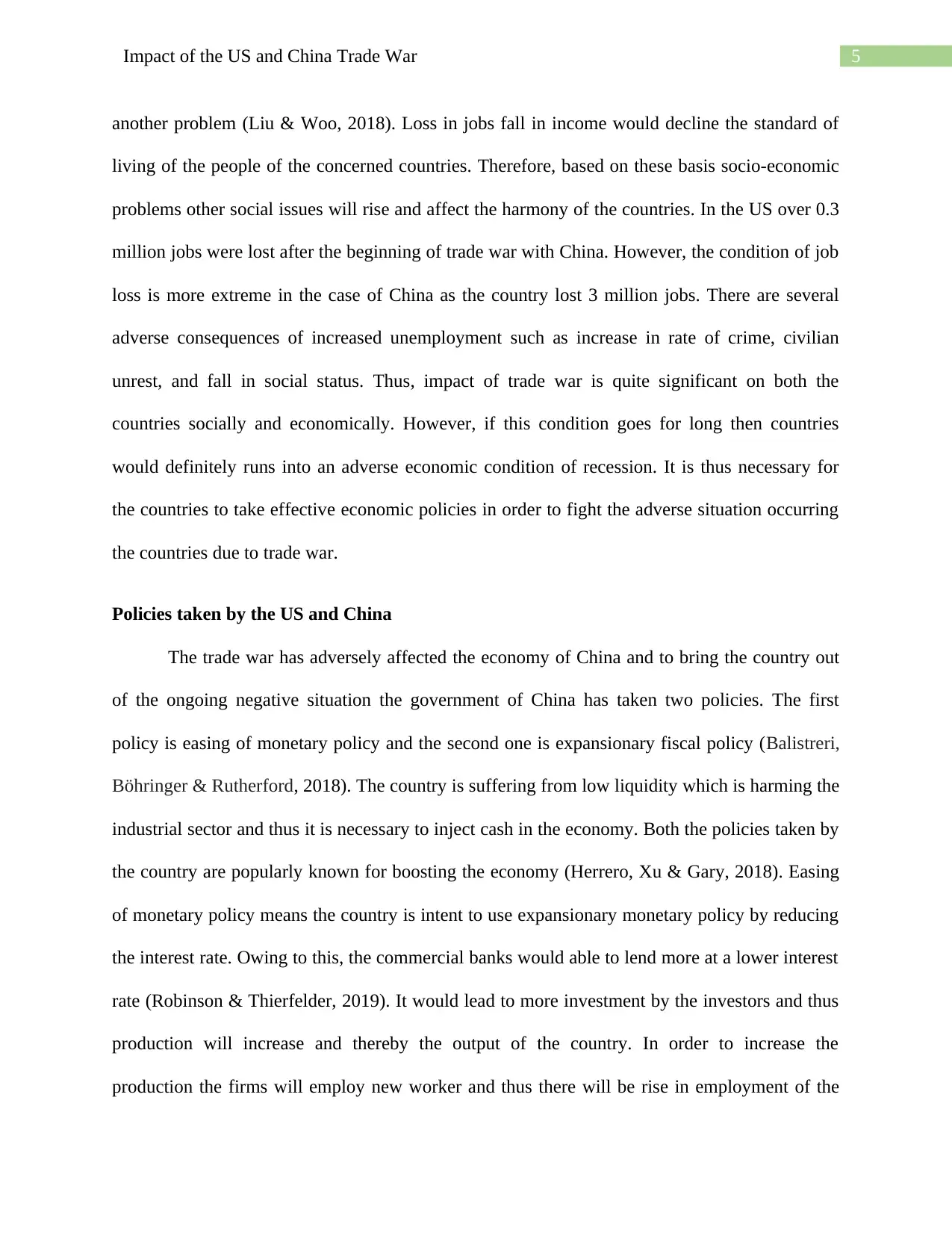
5Impact of the US and China Trade War
another problem (Liu & Woo, 2018). Loss in jobs fall in income would decline the standard of
living of the people of the concerned countries. Therefore, based on these basis socio-economic
problems other social issues will rise and affect the harmony of the countries. In the US over 0.3
million jobs were lost after the beginning of trade war with China. However, the condition of job
loss is more extreme in the case of China as the country lost 3 million jobs. There are several
adverse consequences of increased unemployment such as increase in rate of crime, civilian
unrest, and fall in social status. Thus, impact of trade war is quite significant on both the
countries socially and economically. However, if this condition goes for long then countries
would definitely runs into an adverse economic condition of recession. It is thus necessary for
the countries to take effective economic policies in order to fight the adverse situation occurring
the countries due to trade war.
Policies taken by the US and China
The trade war has adversely affected the economy of China and to bring the country out
of the ongoing negative situation the government of China has taken two policies. The first
policy is easing of monetary policy and the second one is expansionary fiscal policy (Balistreri,
Böhringer & Rutherford, 2018). The country is suffering from low liquidity which is harming the
industrial sector and thus it is necessary to inject cash in the economy. Both the policies taken by
the country are popularly known for boosting the economy (Herrero, Xu & Gary, 2018). Easing
of monetary policy means the country is intent to use expansionary monetary policy by reducing
the interest rate. Owing to this, the commercial banks would able to lend more at a lower interest
rate (Robinson & Thierfelder, 2019). It would lead to more investment by the investors and thus
production will increase and thereby the output of the country. In order to increase the
production the firms will employ new worker and thus there will be rise in employment of the
another problem (Liu & Woo, 2018). Loss in jobs fall in income would decline the standard of
living of the people of the concerned countries. Therefore, based on these basis socio-economic
problems other social issues will rise and affect the harmony of the countries. In the US over 0.3
million jobs were lost after the beginning of trade war with China. However, the condition of job
loss is more extreme in the case of China as the country lost 3 million jobs. There are several
adverse consequences of increased unemployment such as increase in rate of crime, civilian
unrest, and fall in social status. Thus, impact of trade war is quite significant on both the
countries socially and economically. However, if this condition goes for long then countries
would definitely runs into an adverse economic condition of recession. It is thus necessary for
the countries to take effective economic policies in order to fight the adverse situation occurring
the countries due to trade war.
Policies taken by the US and China
The trade war has adversely affected the economy of China and to bring the country out
of the ongoing negative situation the government of China has taken two policies. The first
policy is easing of monetary policy and the second one is expansionary fiscal policy (Balistreri,
Böhringer & Rutherford, 2018). The country is suffering from low liquidity which is harming the
industrial sector and thus it is necessary to inject cash in the economy. Both the policies taken by
the country are popularly known for boosting the economy (Herrero, Xu & Gary, 2018). Easing
of monetary policy means the country is intent to use expansionary monetary policy by reducing
the interest rate. Owing to this, the commercial banks would able to lend more at a lower interest
rate (Robinson & Thierfelder, 2019). It would lead to more investment by the investors and thus
production will increase and thereby the output of the country. In order to increase the
production the firms will employ new worker and thus there will be rise in employment of the
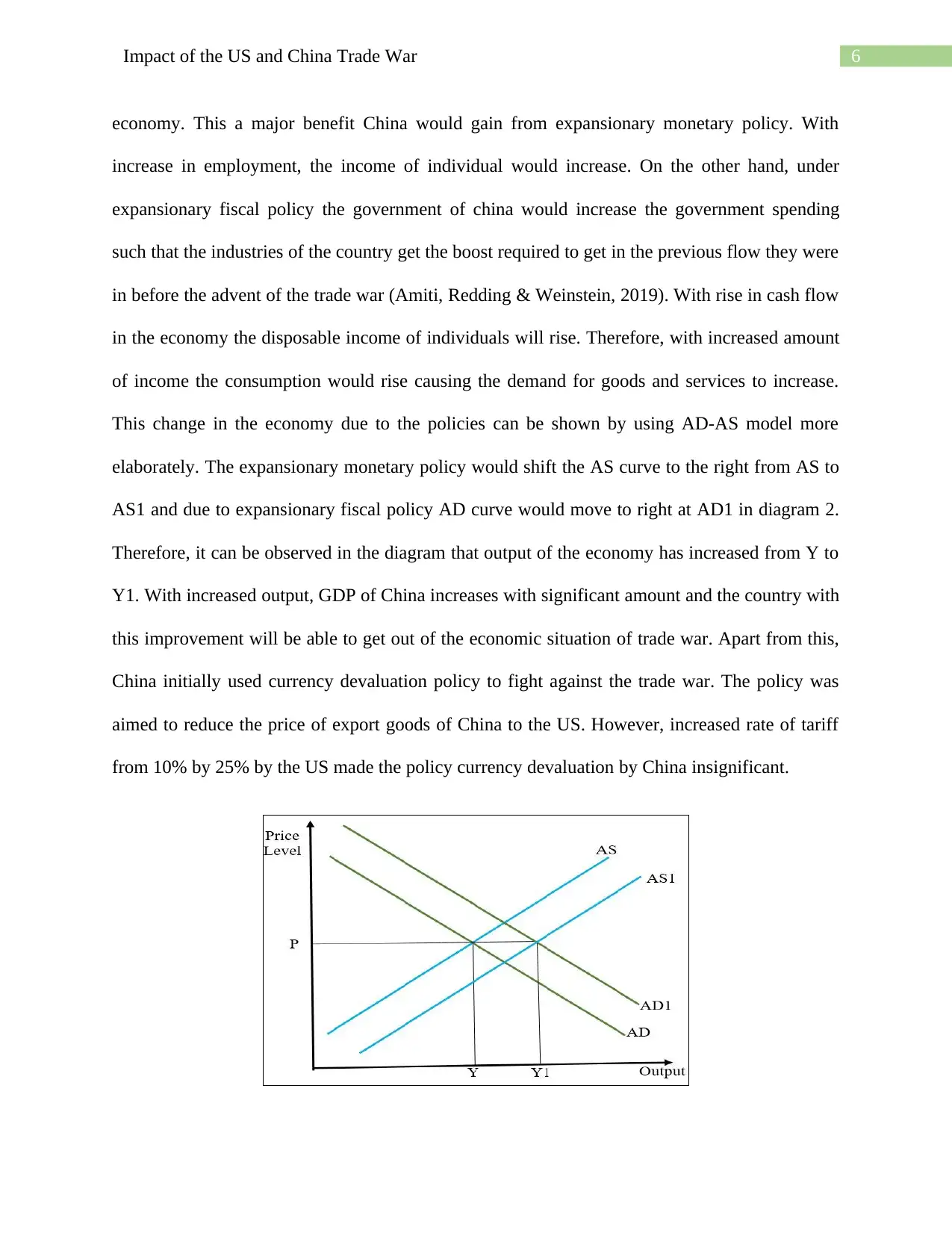
6Impact of the US and China Trade War
economy. This a major benefit China would gain from expansionary monetary policy. With
increase in employment, the income of individual would increase. On the other hand, under
expansionary fiscal policy the government of china would increase the government spending
such that the industries of the country get the boost required to get in the previous flow they were
in before the advent of the trade war (Amiti, Redding & Weinstein, 2019). With rise in cash flow
in the economy the disposable income of individuals will rise. Therefore, with increased amount
of income the consumption would rise causing the demand for goods and services to increase.
This change in the economy due to the policies can be shown by using AD-AS model more
elaborately. The expansionary monetary policy would shift the AS curve to the right from AS to
AS1 and due to expansionary fiscal policy AD curve would move to right at AD1 in diagram 2.
Therefore, it can be observed in the diagram that output of the economy has increased from Y to
Y1. With increased output, GDP of China increases with significant amount and the country with
this improvement will be able to get out of the economic situation of trade war. Apart from this,
China initially used currency devaluation policy to fight against the trade war. The policy was
aimed to reduce the price of export goods of China to the US. However, increased rate of tariff
from 10% by 25% by the US made the policy currency devaluation by China insignificant.
economy. This a major benefit China would gain from expansionary monetary policy. With
increase in employment, the income of individual would increase. On the other hand, under
expansionary fiscal policy the government of china would increase the government spending
such that the industries of the country get the boost required to get in the previous flow they were
in before the advent of the trade war (Amiti, Redding & Weinstein, 2019). With rise in cash flow
in the economy the disposable income of individuals will rise. Therefore, with increased amount
of income the consumption would rise causing the demand for goods and services to increase.
This change in the economy due to the policies can be shown by using AD-AS model more
elaborately. The expansionary monetary policy would shift the AS curve to the right from AS to
AS1 and due to expansionary fiscal policy AD curve would move to right at AD1 in diagram 2.
Therefore, it can be observed in the diagram that output of the economy has increased from Y to
Y1. With increased output, GDP of China increases with significant amount and the country with
this improvement will be able to get out of the economic situation of trade war. Apart from this,
China initially used currency devaluation policy to fight against the trade war. The policy was
aimed to reduce the price of export goods of China to the US. However, increased rate of tariff
from 10% by 25% by the US made the policy currency devaluation by China insignificant.
Paraphrase This Document
Need a fresh take? Get an instant paraphrase of this document with our AI Paraphraser
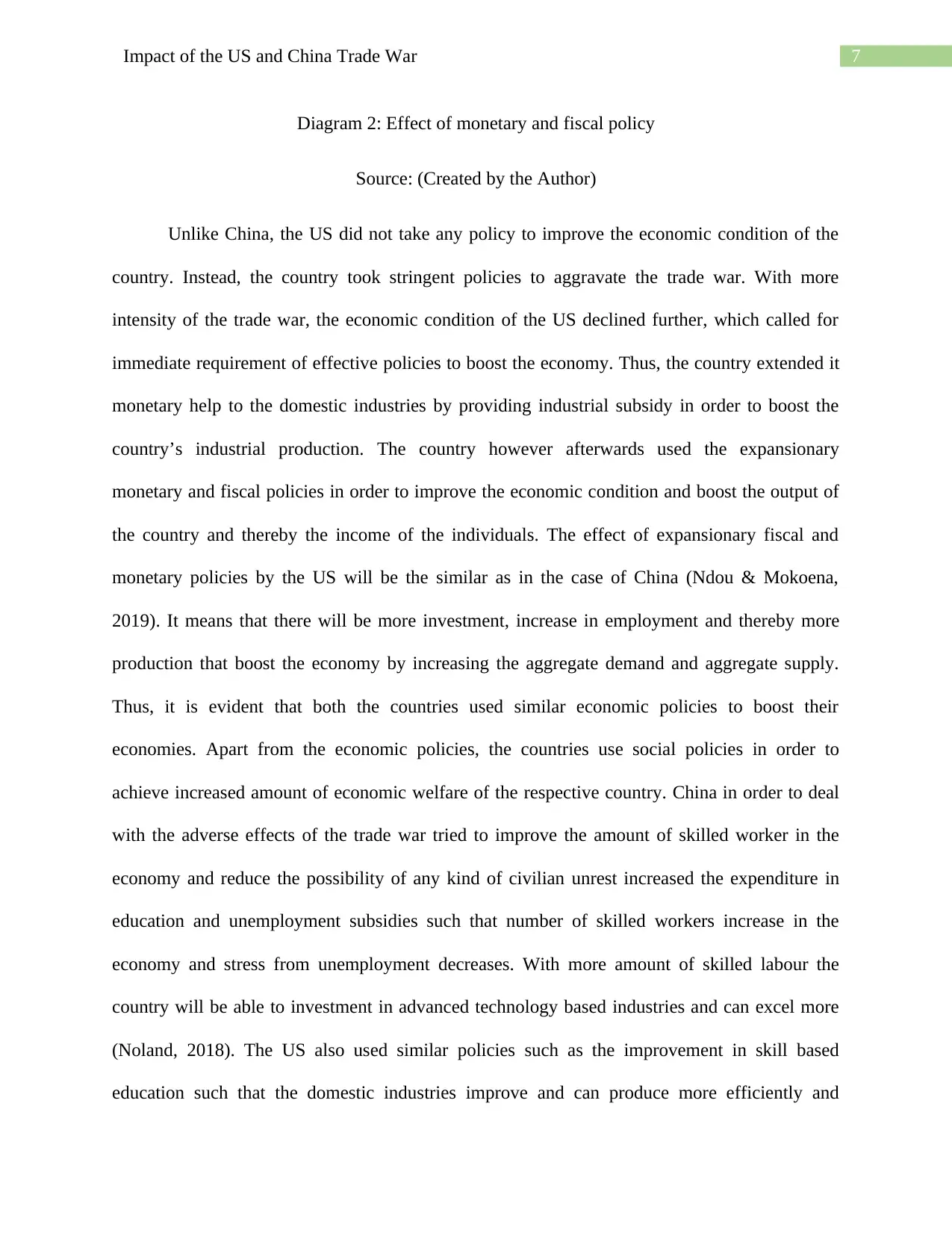
7Impact of the US and China Trade War
Diagram 2: Effect of monetary and fiscal policy
Source: (Created by the Author)
Unlike China, the US did not take any policy to improve the economic condition of the
country. Instead, the country took stringent policies to aggravate the trade war. With more
intensity of the trade war, the economic condition of the US declined further, which called for
immediate requirement of effective policies to boost the economy. Thus, the country extended it
monetary help to the domestic industries by providing industrial subsidy in order to boost the
country’s industrial production. The country however afterwards used the expansionary
monetary and fiscal policies in order to improve the economic condition and boost the output of
the country and thereby the income of the individuals. The effect of expansionary fiscal and
monetary policies by the US will be the similar as in the case of China (Ndou & Mokoena,
2019). It means that there will be more investment, increase in employment and thereby more
production that boost the economy by increasing the aggregate demand and aggregate supply.
Thus, it is evident that both the countries used similar economic policies to boost their
economies. Apart from the economic policies, the countries use social policies in order to
achieve increased amount of economic welfare of the respective country. China in order to deal
with the adverse effects of the trade war tried to improve the amount of skilled worker in the
economy and reduce the possibility of any kind of civilian unrest increased the expenditure in
education and unemployment subsidies such that number of skilled workers increase in the
economy and stress from unemployment decreases. With more amount of skilled labour the
country will be able to investment in advanced technology based industries and can excel more
(Noland, 2018). The US also used similar policies such as the improvement in skill based
education such that the domestic industries improve and can produce more efficiently and
Diagram 2: Effect of monetary and fiscal policy
Source: (Created by the Author)
Unlike China, the US did not take any policy to improve the economic condition of the
country. Instead, the country took stringent policies to aggravate the trade war. With more
intensity of the trade war, the economic condition of the US declined further, which called for
immediate requirement of effective policies to boost the economy. Thus, the country extended it
monetary help to the domestic industries by providing industrial subsidy in order to boost the
country’s industrial production. The country however afterwards used the expansionary
monetary and fiscal policies in order to improve the economic condition and boost the output of
the country and thereby the income of the individuals. The effect of expansionary fiscal and
monetary policies by the US will be the similar as in the case of China (Ndou & Mokoena,
2019). It means that there will be more investment, increase in employment and thereby more
production that boost the economy by increasing the aggregate demand and aggregate supply.
Thus, it is evident that both the countries used similar economic policies to boost their
economies. Apart from the economic policies, the countries use social policies in order to
achieve increased amount of economic welfare of the respective country. China in order to deal
with the adverse effects of the trade war tried to improve the amount of skilled worker in the
economy and reduce the possibility of any kind of civilian unrest increased the expenditure in
education and unemployment subsidies such that number of skilled workers increase in the
economy and stress from unemployment decreases. With more amount of skilled labour the
country will be able to investment in advanced technology based industries and can excel more
(Noland, 2018). The US also used similar policies such as the improvement in skill based
education such that the domestic industries improve and can produce more efficiently and
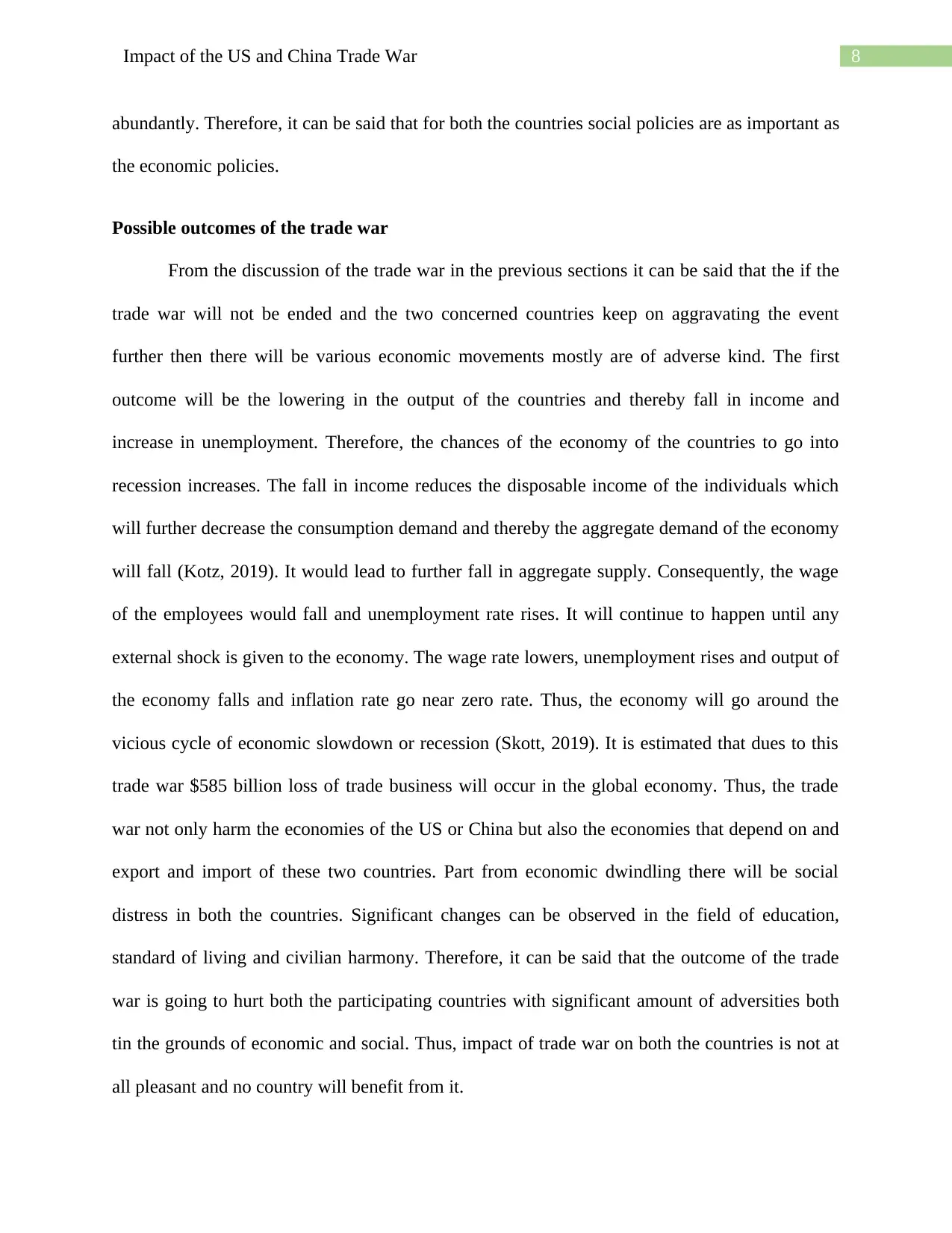
8Impact of the US and China Trade War
abundantly. Therefore, it can be said that for both the countries social policies are as important as
the economic policies.
Possible outcomes of the trade war
From the discussion of the trade war in the previous sections it can be said that the if the
trade war will not be ended and the two concerned countries keep on aggravating the event
further then there will be various economic movements mostly are of adverse kind. The first
outcome will be the lowering in the output of the countries and thereby fall in income and
increase in unemployment. Therefore, the chances of the economy of the countries to go into
recession increases. The fall in income reduces the disposable income of the individuals which
will further decrease the consumption demand and thereby the aggregate demand of the economy
will fall (Kotz, 2019). It would lead to further fall in aggregate supply. Consequently, the wage
of the employees would fall and unemployment rate rises. It will continue to happen until any
external shock is given to the economy. The wage rate lowers, unemployment rises and output of
the economy falls and inflation rate go near zero rate. Thus, the economy will go around the
vicious cycle of economic slowdown or recession (Skott, 2019). It is estimated that dues to this
trade war $585 billion loss of trade business will occur in the global economy. Thus, the trade
war not only harm the economies of the US or China but also the economies that depend on and
export and import of these two countries. Part from economic dwindling there will be social
distress in both the countries. Significant changes can be observed in the field of education,
standard of living and civilian harmony. Therefore, it can be said that the outcome of the trade
war is going to hurt both the participating countries with significant amount of adversities both
tin the grounds of economic and social. Thus, impact of trade war on both the countries is not at
all pleasant and no country will benefit from it.
abundantly. Therefore, it can be said that for both the countries social policies are as important as
the economic policies.
Possible outcomes of the trade war
From the discussion of the trade war in the previous sections it can be said that the if the
trade war will not be ended and the two concerned countries keep on aggravating the event
further then there will be various economic movements mostly are of adverse kind. The first
outcome will be the lowering in the output of the countries and thereby fall in income and
increase in unemployment. Therefore, the chances of the economy of the countries to go into
recession increases. The fall in income reduces the disposable income of the individuals which
will further decrease the consumption demand and thereby the aggregate demand of the economy
will fall (Kotz, 2019). It would lead to further fall in aggregate supply. Consequently, the wage
of the employees would fall and unemployment rate rises. It will continue to happen until any
external shock is given to the economy. The wage rate lowers, unemployment rises and output of
the economy falls and inflation rate go near zero rate. Thus, the economy will go around the
vicious cycle of economic slowdown or recession (Skott, 2019). It is estimated that dues to this
trade war $585 billion loss of trade business will occur in the global economy. Thus, the trade
war not only harm the economies of the US or China but also the economies that depend on and
export and import of these two countries. Part from economic dwindling there will be social
distress in both the countries. Significant changes can be observed in the field of education,
standard of living and civilian harmony. Therefore, it can be said that the outcome of the trade
war is going to hurt both the participating countries with significant amount of adversities both
tin the grounds of economic and social. Thus, impact of trade war on both the countries is not at
all pleasant and no country will benefit from it.
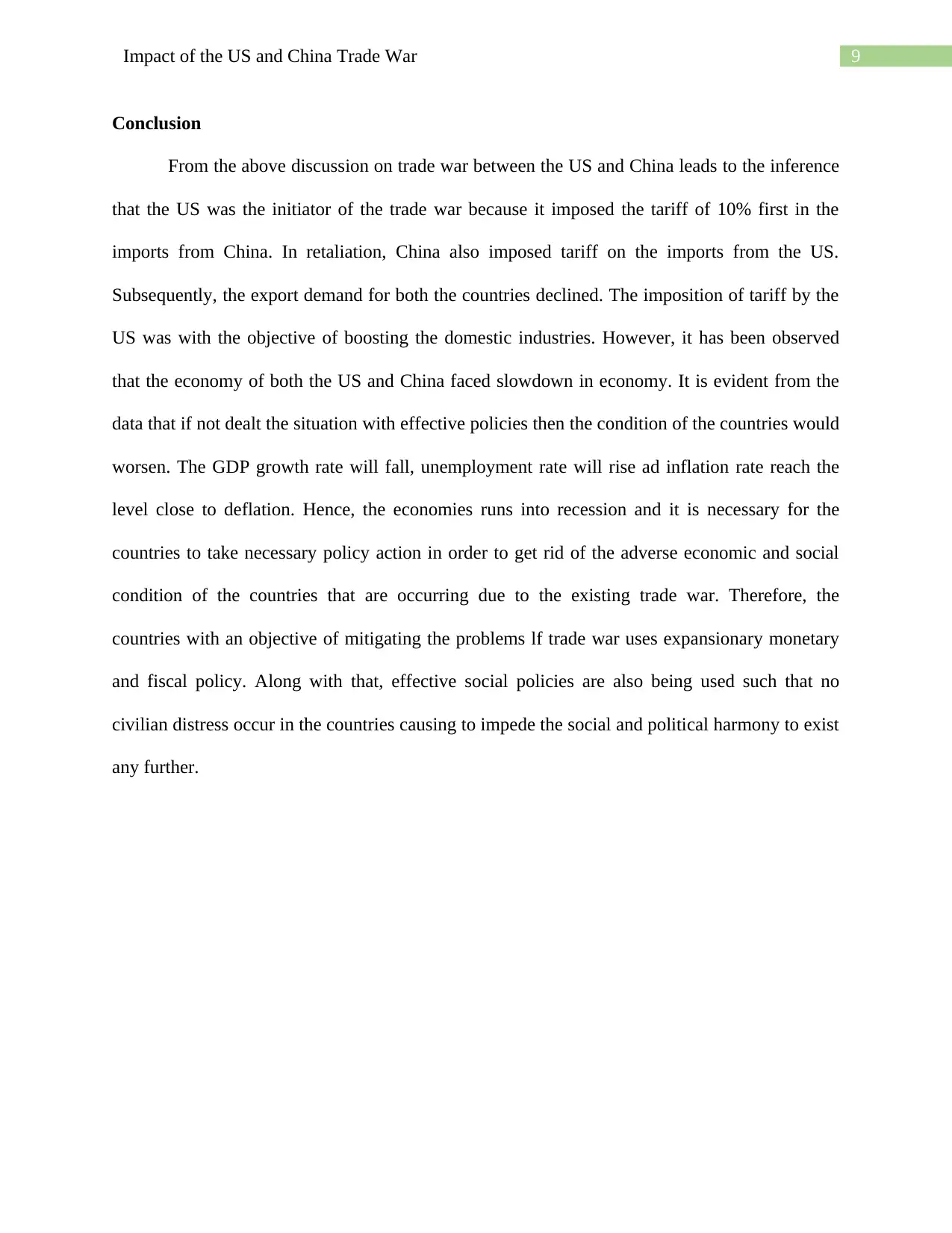
9Impact of the US and China Trade War
Conclusion
From the above discussion on trade war between the US and China leads to the inference
that the US was the initiator of the trade war because it imposed the tariff of 10% first in the
imports from China. In retaliation, China also imposed tariff on the imports from the US.
Subsequently, the export demand for both the countries declined. The imposition of tariff by the
US was with the objective of boosting the domestic industries. However, it has been observed
that the economy of both the US and China faced slowdown in economy. It is evident from the
data that if not dealt the situation with effective policies then the condition of the countries would
worsen. The GDP growth rate will fall, unemployment rate will rise ad inflation rate reach the
level close to deflation. Hence, the economies runs into recession and it is necessary for the
countries to take necessary policy action in order to get rid of the adverse economic and social
condition of the countries that are occurring due to the existing trade war. Therefore, the
countries with an objective of mitigating the problems lf trade war uses expansionary monetary
and fiscal policy. Along with that, effective social policies are also being used such that no
civilian distress occur in the countries causing to impede the social and political harmony to exist
any further.
Conclusion
From the above discussion on trade war between the US and China leads to the inference
that the US was the initiator of the trade war because it imposed the tariff of 10% first in the
imports from China. In retaliation, China also imposed tariff on the imports from the US.
Subsequently, the export demand for both the countries declined. The imposition of tariff by the
US was with the objective of boosting the domestic industries. However, it has been observed
that the economy of both the US and China faced slowdown in economy. It is evident from the
data that if not dealt the situation with effective policies then the condition of the countries would
worsen. The GDP growth rate will fall, unemployment rate will rise ad inflation rate reach the
level close to deflation. Hence, the economies runs into recession and it is necessary for the
countries to take necessary policy action in order to get rid of the adverse economic and social
condition of the countries that are occurring due to the existing trade war. Therefore, the
countries with an objective of mitigating the problems lf trade war uses expansionary monetary
and fiscal policy. Along with that, effective social policies are also being used such that no
civilian distress occur in the countries causing to impede the social and political harmony to exist
any further.
Secure Best Marks with AI Grader
Need help grading? Try our AI Grader for instant feedback on your assignments.
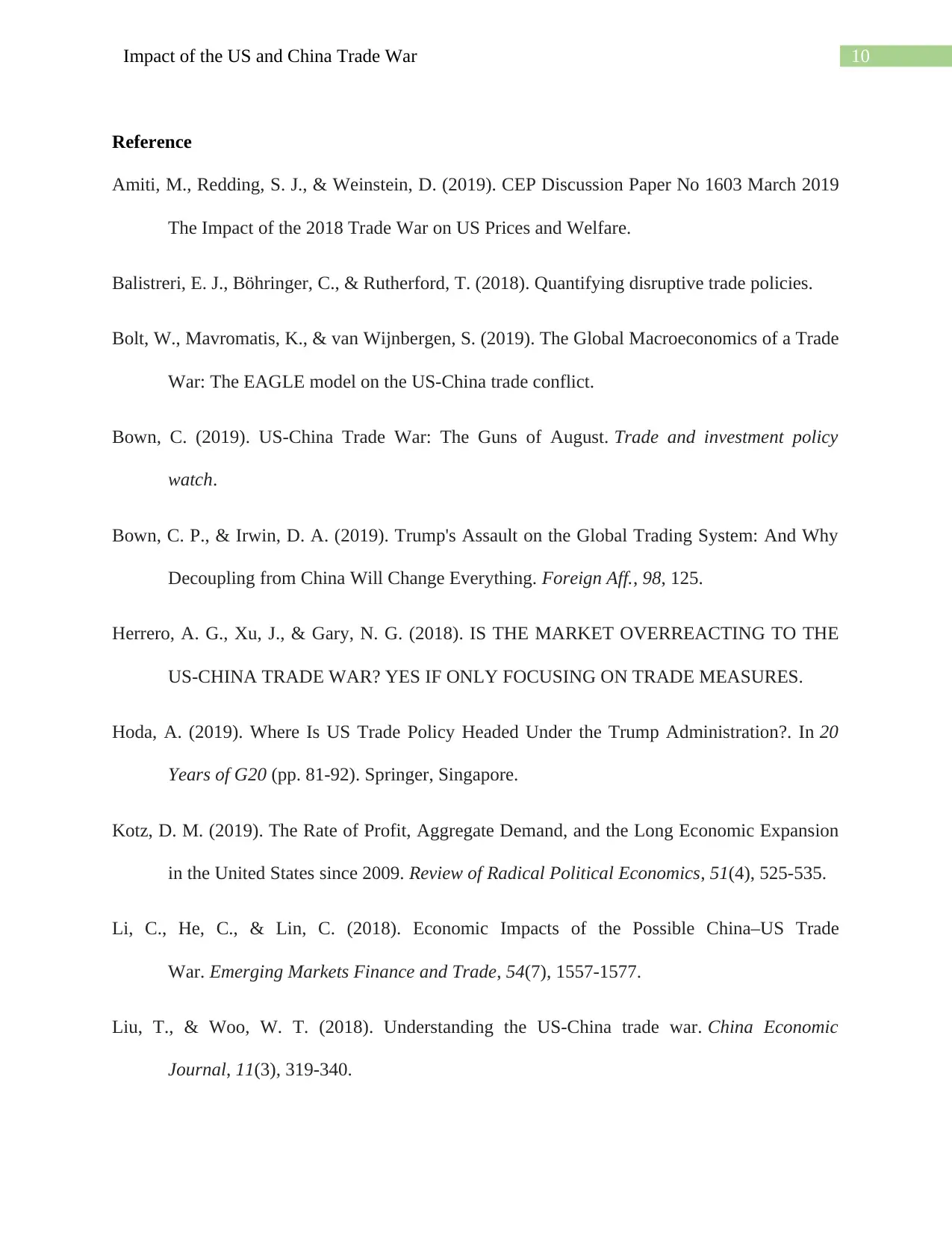
10Impact of the US and China Trade War
Reference
Amiti, M., Redding, S. J., & Weinstein, D. (2019). CEP Discussion Paper No 1603 March 2019
The Impact of the 2018 Trade War on US Prices and Welfare.
Balistreri, E. J., Böhringer, C., & Rutherford, T. (2018). Quantifying disruptive trade policies.
Bolt, W., Mavromatis, K., & van Wijnbergen, S. (2019). The Global Macroeconomics of a Trade
War: The EAGLE model on the US-China trade conflict.
Bown, C. (2019). US-China Trade War: The Guns of August. Trade and investment policy
watch.
Bown, C. P., & Irwin, D. A. (2019). Trump's Assault on the Global Trading System: And Why
Decoupling from China Will Change Everything. Foreign Aff., 98, 125.
Herrero, A. G., Xu, J., & Gary, N. G. (2018). IS THE MARKET OVERREACTING TO THE
US-CHINA TRADE WAR? YES IF ONLY FOCUSING ON TRADE MEASURES.
Hoda, A. (2019). Where Is US Trade Policy Headed Under the Trump Administration?. In 20
Years of G20 (pp. 81-92). Springer, Singapore.
Kotz, D. M. (2019). The Rate of Profit, Aggregate Demand, and the Long Economic Expansion
in the United States since 2009. Review of Radical Political Economics, 51(4), 525-535.
Li, C., He, C., & Lin, C. (2018). Economic Impacts of the Possible China–US Trade
War. Emerging Markets Finance and Trade, 54(7), 1557-1577.
Liu, T., & Woo, W. T. (2018). Understanding the US-China trade war. China Economic
Journal, 11(3), 319-340.
Reference
Amiti, M., Redding, S. J., & Weinstein, D. (2019). CEP Discussion Paper No 1603 March 2019
The Impact of the 2018 Trade War on US Prices and Welfare.
Balistreri, E. J., Böhringer, C., & Rutherford, T. (2018). Quantifying disruptive trade policies.
Bolt, W., Mavromatis, K., & van Wijnbergen, S. (2019). The Global Macroeconomics of a Trade
War: The EAGLE model on the US-China trade conflict.
Bown, C. (2019). US-China Trade War: The Guns of August. Trade and investment policy
watch.
Bown, C. P., & Irwin, D. A. (2019). Trump's Assault on the Global Trading System: And Why
Decoupling from China Will Change Everything. Foreign Aff., 98, 125.
Herrero, A. G., Xu, J., & Gary, N. G. (2018). IS THE MARKET OVERREACTING TO THE
US-CHINA TRADE WAR? YES IF ONLY FOCUSING ON TRADE MEASURES.
Hoda, A. (2019). Where Is US Trade Policy Headed Under the Trump Administration?. In 20
Years of G20 (pp. 81-92). Springer, Singapore.
Kotz, D. M. (2019). The Rate of Profit, Aggregate Demand, and the Long Economic Expansion
in the United States since 2009. Review of Radical Political Economics, 51(4), 525-535.
Li, C., He, C., & Lin, C. (2018). Economic Impacts of the Possible China–US Trade
War. Emerging Markets Finance and Trade, 54(7), 1557-1577.
Liu, T., & Woo, W. T. (2018). Understanding the US-China trade war. China Economic
Journal, 11(3), 319-340.
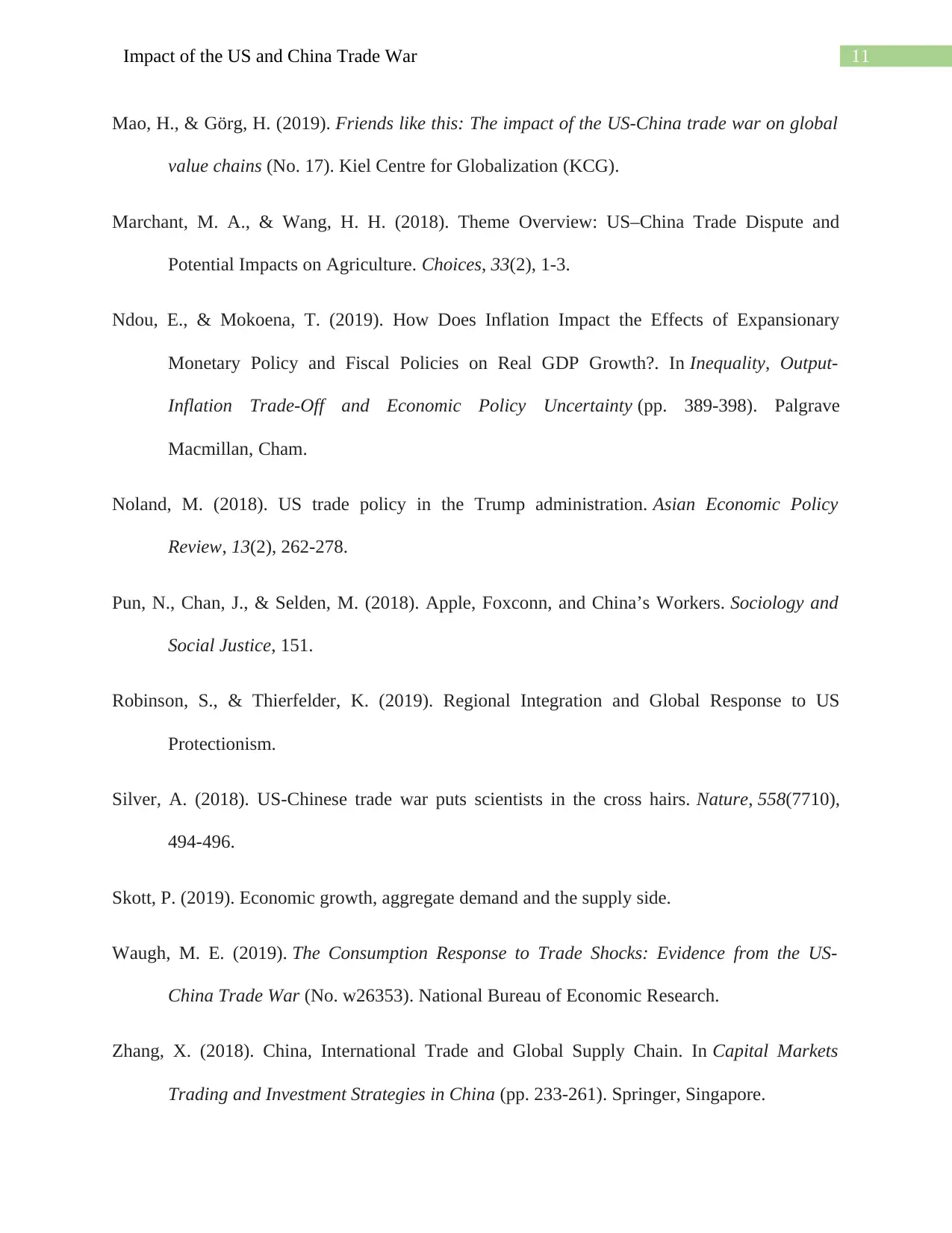
11Impact of the US and China Trade War
Mao, H., & Görg, H. (2019). Friends like this: The impact of the US-China trade war on global
value chains (No. 17). Kiel Centre for Globalization (KCG).
Marchant, M. A., & Wang, H. H. (2018). Theme Overview: US–China Trade Dispute and
Potential Impacts on Agriculture. Choices, 33(2), 1-3.
Ndou, E., & Mokoena, T. (2019). How Does Inflation Impact the Effects of Expansionary
Monetary Policy and Fiscal Policies on Real GDP Growth?. In Inequality, Output-
Inflation Trade-Off and Economic Policy Uncertainty (pp. 389-398). Palgrave
Macmillan, Cham.
Noland, M. (2018). US trade policy in the Trump administration. Asian Economic Policy
Review, 13(2), 262-278.
Pun, N., Chan, J., & Selden, M. (2018). Apple, Foxconn, and China’s Workers. Sociology and
Social Justice, 151.
Robinson, S., & Thierfelder, K. (2019). Regional Integration and Global Response to US
Protectionism.
Silver, A. (2018). US-Chinese trade war puts scientists in the cross hairs. Nature, 558(7710),
494-496.
Skott, P. (2019). Economic growth, aggregate demand and the supply side.
Waugh, M. E. (2019). The Consumption Response to Trade Shocks: Evidence from the US-
China Trade War (No. w26353). National Bureau of Economic Research.
Zhang, X. (2018). China, International Trade and Global Supply Chain. In Capital Markets
Trading and Investment Strategies in China (pp. 233-261). Springer, Singapore.
Mao, H., & Görg, H. (2019). Friends like this: The impact of the US-China trade war on global
value chains (No. 17). Kiel Centre for Globalization (KCG).
Marchant, M. A., & Wang, H. H. (2018). Theme Overview: US–China Trade Dispute and
Potential Impacts on Agriculture. Choices, 33(2), 1-3.
Ndou, E., & Mokoena, T. (2019). How Does Inflation Impact the Effects of Expansionary
Monetary Policy and Fiscal Policies on Real GDP Growth?. In Inequality, Output-
Inflation Trade-Off and Economic Policy Uncertainty (pp. 389-398). Palgrave
Macmillan, Cham.
Noland, M. (2018). US trade policy in the Trump administration. Asian Economic Policy
Review, 13(2), 262-278.
Pun, N., Chan, J., & Selden, M. (2018). Apple, Foxconn, and China’s Workers. Sociology and
Social Justice, 151.
Robinson, S., & Thierfelder, K. (2019). Regional Integration and Global Response to US
Protectionism.
Silver, A. (2018). US-Chinese trade war puts scientists in the cross hairs. Nature, 558(7710),
494-496.
Skott, P. (2019). Economic growth, aggregate demand and the supply side.
Waugh, M. E. (2019). The Consumption Response to Trade Shocks: Evidence from the US-
China Trade War (No. w26353). National Bureau of Economic Research.
Zhang, X. (2018). China, International Trade and Global Supply Chain. In Capital Markets
Trading and Investment Strategies in China (pp. 233-261). Springer, Singapore.

12Impact of the US and China Trade War
1 out of 13
Related Documents
Your All-in-One AI-Powered Toolkit for Academic Success.
+13062052269
info@desklib.com
Available 24*7 on WhatsApp / Email
![[object Object]](/_next/static/media/star-bottom.7253800d.svg)
Unlock your academic potential
© 2024 | Zucol Services PVT LTD | All rights reserved.




